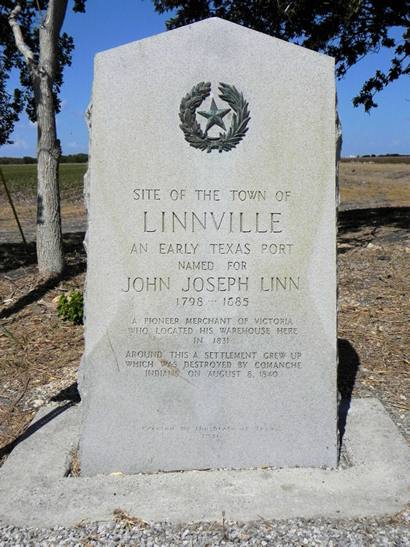|
The Linnville
Centennial marker at the
northern City Limit of Port Lavaca
on FM 1090.
Photo Courtesy Barclay
Gibson, August 2013 |
History in
a Pecan Shell
Originally
known as New Port, it was named after John J. Linn, a merchant
who owned warehouses here. It was an important port of entry during
the 1830s. A community sprang up around the warehouses owned by Linn
and others and by 1839 the population was estimated at 200. At that
time the town even had a hotel for the convenience of arriving immigrants.
All that is left of the town is a marker erected in 1936 commemorating
the now famous "Last
Raid" of the Comanche Indians.
The raid which began in the Hill
Country, consisted of a seizable group of warriors who swept down
to the coast, attacking settlements along the way, including the seizable
town of Victoria. Linnville
was attacked on August 8th 1840. Many residents fled into the waters
of the bay to escape death and after looting the warehouses in a search
for guns, the Comanches returned the way they came. The Texas militia
had formed while the Indians were at the coast and met them at Plum
Creek (near present-day downtown Lockhart).
The resulting Battle
of Plum Creek stopped further incursions by the Comanches, who
then retreated far from white settlements.
See Cox's Point.
Only a single building was left standing in Linnville and residents
fled the site to form the town of La Vaca (today the city of Port
Lavaca). As La Vaca grew, Linnville declined and was soon abandoned.
|
 |
The Linnville
Centennial marker
Photo Courtesy Barclay
Gibson, August 2013 |
The Linnville
Centennial marker
Photo Courtesy Barclay
Gibson, August 2013 |
1907 Calhoun
County Postal Map showing Port
Lavaca and Lavaca Bay
From 1907 Texas state map #2090
Courtesy Texas General Land Office |
| Texas
Escapes, in its purpose to preserve historic, endangered and vanishing
Texas, asks that anyone wishing to share their local history, stories,
landmarks and recent or vintage photos, please contact
us. |
|
|
